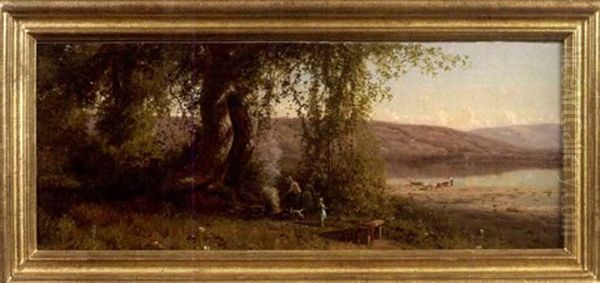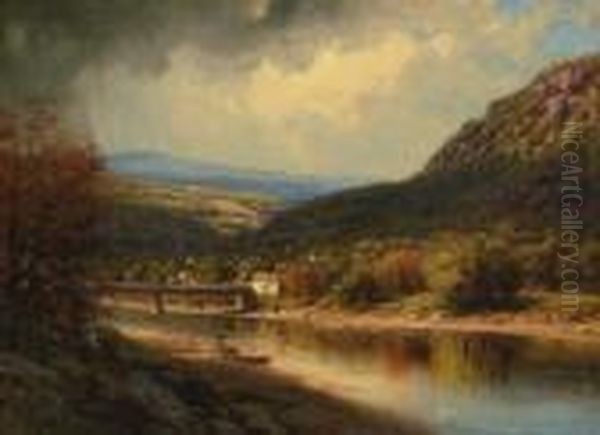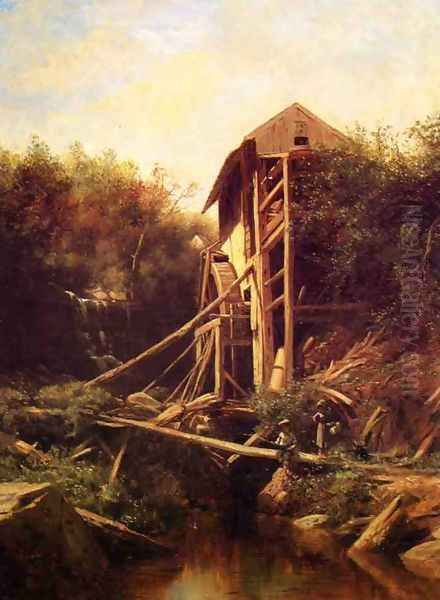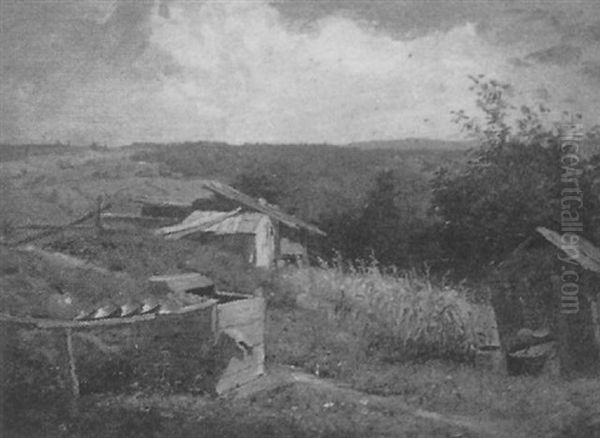George Lafayette Clough stands as a notable figure in the panorama of 19th-century American art. An artist whose career bridged the era of burgeoning national identity with the evolving tastes of a rapidly changing society, Clough dedicated his life to capturing the sublime beauty of the American wilderness and the dignified character of its people. Though perhaps not as universally recognized today as some of his towering contemporaries, his contributions, particularly to the Hudson River School tradition and the documentation of regional landscapes, remain significant. His journey from a challenging childhood to a respected professional artist is a testament to his dedication and innate talent.
Early Life and Artistic Awakening in Auburn
George Lafayette Clough was born on September 18, 1824, in Auburn, New York. His early life was marked by hardship. His father was absent, and his mother passed away shortly after his birth, leaving him to navigate his formative years without direct parental influence. This difficult start meant his formal education was limited. Necessity dictated that he begin working at the tender age of ten. However, the artistic impulse was strong within him. By fifteen, around 1839, Clough began to explore his burgeoning interest in painting.
His initial foray into the art world was guided by Randall Palmer, a local portrait painter in Auburn. Palmer provided Clough with his first rudimentary instruction, likely focusing on the fundamentals of drawing and likeness, skills essential for any aspiring artist of the time, especially one who might need to earn a living through commissions. This early exposure to portraiture would lay a foundation for a part of his later career, though his ultimate passion would lie in the depiction of nature. The environment of upstate New York, with its rolling hills, pristine lakes, and dense forests, undoubtedly played a role in shaping his artistic sensibilities from a young age.
Formal Training and the European Sojourn

Recognizing the need for more structured training, Clough took a significant step in 1844. He opened his own studio in Auburn, a bold move for a young, largely self-taught artist. This studio not only served as a place for him to work but also as a base from which to seek further instruction. It was during this period that he began to receive more formal guidance from Charles Loring Elliott (1812-1868), a prominent portrait painter of the era. Elliott, who himself had studied with John Trumbull and Gilbert Stuart, was known for his insightful and characterful portraits.
Under Elliott's tutelage, Clough honed his skills, particularly in capturing the human form and conveying personality. He spent several months in Elliott's New York City studio around 1847, an experience that would have immersed him in a more competitive and professional artistic environment. This period was crucial in transforming him into a proficient portrait painter, a skill that provided a reliable source of income for many artists.
However, like many ambitious American artists of his generation, Clough felt the pull of Europe. In the early 1850s, he embarked on a journey to the continent, visiting France, the Netherlands, Italy, and Germany. This was a traditional "Grand Tour" of sorts, aimed at studying the Old Masters firsthand, absorbing different artistic traditions, and copying significant works in major galleries like the Louvre. This experience was invaluable, exposing him to a wider range of styles and techniques than available in America. He paid close attention to European landscape traditions, which would significantly inform his subsequent work upon his return to the United States.
A Career in Landscape: The Hudson River School and Beyond
Upon returning from Europe, George Lafayette Clough increasingly dedicated himself to landscape painting, the genre for which he would become best known. He became associated with the Hudson River School, America's first true school of landscape painting. This movement, which flourished from the 1820s to roughly the 1870s, was characterized by a romantic and detailed depiction of the American wilderness, often imbued with a sense of awe and national pride. Artists of this school sought to capture the unique character of the American landscape, seeing it as a new Eden and a reflection of divine providence.

Clough’s work fits comfortably within the stylistic and thematic concerns of the later phase of the Hudson River School. His paintings often featured the scenic vistas of upstate New York, particularly the Adirondack Mountains, a favorite subject for many artists of the school due to its rugged beauty and pristine wilderness. He also painted scenes in Pennsylvania, New England (including New Hampshire's forests), and eastern Ohio. His landscapes are characterized by careful observation, a sensitivity to light and atmosphere, and a desire to convey the tranquility and grandeur of nature.
While portraiture remained a part of his practice, landscapes became his primary focus. He was adept at capturing the specific qualities of a location, from the serene waters of a mountain lake to the dense foliage of an autumnal forest. His style, while rooted in the detailed realism of the Hudson River School, also showed an awareness of contemporary European trends, possibly the influence of the Barbizon School painters like Jean-Baptiste-Camille Corot or Théodore Rousseau, whose work he may have encountered during his travels. These artists emphasized a more direct and less idealized approach to nature, focusing on mood and atmosphere.
Themes, Subjects, and Artistic Style
Clough's oeuvre primarily revolved around the depiction of the natural world. His landscapes often celebrated the pastoral and the untouched wilderness. He was particularly drawn to the Adirondack Mountains, a region that captivated many of his contemporaries, including artists like Asher B. Durand (1796-1886), a leading figure of the Hudson River School, and later, Winslow Homer (1836-1910), who famously painted hunting and fishing scenes there. Clough's Adirondack scenes convey a sense of solitude and the sublime power of nature.
Owasco Lake, near his hometown of Auburn, was another recurring subject. His depictions of the lake and its surroundings often highlight the changing seasons, a common theme for Hudson River School painters who were keen observers of nature's cycles. The interplay of light on water, the vibrant colors of autumn foliage, and the hazy atmosphere of a summer day were all rendered with skill and sensitivity.
In terms of style, Clough's work generally adhered to the tenets of realistic representation favored by the Hudson River School. He paid close attention to detail in rendering trees, rocks, and water, yet his paintings were not merely topographical records. They often possessed a lyrical quality, evoking a particular mood or feeling. His compositions were typically well-balanced, leading the viewer's eye into the scene, often towards a distant, light-filled horizon, a characteristic feature in many Hudson River School paintings that symbolized hope or the divine.

Later in his career, particularly after moving to Cleveland around 1862, Clough also began to paint cityscapes. This shift reflected the growing urbanization of America and the changing interests of artists and patrons. These urban views, while less numerous than his wilderness landscapes, demonstrate his versatility and his ability to adapt his observational skills to different environments.
Notable Works
Several paintings stand out as representative of George Lafayette Clough's artistic output and his contribution to American landscape art.
"Adirondack Lake": This title likely refers to one of his many depictions of the serene and often remote lakes nestled within the Adirondack Mountains. Such works would typically showcase his ability to capture the reflective qualities of water, the textures of the surrounding forests, and the atmospheric effects of mountain air. These paintings resonated with a public eager for images of America's unspoiled wilderness.
"Homestead": This title suggests a more pastoral scene, perhaps depicting a farm or rural dwelling within a landscape. Such paintings were also popular, reflecting an idealized view of agrarian life and the taming of the wilderness. They often conveyed a sense of peace, domesticity, and harmony between human settlement and nature, themes explored by artists like George Inness (1825-1894) in his later, more Tonalist works, though Clough's approach would likely have been more detailed and less overtly spiritualized than Inness's mature style.
"East Side of Owasco Lake, Durham, N.Y.": This specific title points to his deep connection with his local Cayuga County scenery. Paintings of Owasco Lake would have allowed him to explore the subtle nuances of a familiar landscape, capturing its specific light and character throughout the seasons. This work, which fetched a respectable price at auction, underscores the appeal of his regional views.
"A View of the Bridge": This title could refer to a natural rock bridge or a man-made structure within a landscape. If the latter, it would indicate an interest in the signs of human presence and engineering within the natural world, a theme that became more common as the 19th century progressed and artists like Jasper Francis Cropsey (1823-1900) sometimes incorporated railways or bridges into their expansive vistas.

"River Valley Landscape": A more generic title, but one that encapsulates a common subject for Clough and his Hudson River School peers. These paintings often featured a meandering river, fertile valleys, and distant hills or mountains, creating a sense of depth and panoramic scope. Such scenes were emblematic of the American landscape ideal.
These works, and others like them, demonstrate Clough's commitment to capturing the diverse beauty of the American scene, from its wild heartlands to its more settled regions.
Clough and His Contemporaries
George Lafayette Clough operated within a vibrant and evolving American art scene. His direct mentors, Randall Palmer and Charles Loring Elliott, provided him with foundational skills in portraiture. Elliott, in particular, was a highly respected figure, known for his portraits of prominent Americans, and his influence would have been significant.
Clough's brief studio-sharing arrangement with Joseph Meeker in Auburn in 1844 suggests the collegial, and sometimes competitive, nature of artistic communities. Meeker (1827-1887) himself would later become known for his atmospheric paintings of the Louisiana bayous, a very different landscape than Clough's typical subjects.
As a landscape painter in the Hudson River School tradition, Clough was part of a broad artistic movement. He would have been aware of the pioneering work of Thomas Cole (1801-1848), often considered the founder of the school, and Asher B. Durand, who advocated for direct study from nature. His contemporaries included luminaries like Frederic Edwin Church (1826-1900) and Albert Bierstadt (1830-1902), known for their grand, panoramic depictions of South American and Western American landscapes, respectively. While Clough's canvases were generally more modest in scale and focused on the Eastern landscapes, he shared their commitment to detailed realism and the celebration of nature.
Other notable landscape painters of the era whose work Clough might have known or been influenced by include Sanford Robinson Gifford (1823-1880) and John Frederick Kensett (1816-1872), both key figures in the development of Luminism, a style characterized by its subtle rendering of light and atmosphere. While Clough is not typically classified as a Luminist, his sensitivity to atmospheric effects suggests an awareness of these trends.

His time in Europe in the 1850s would have exposed him to the work of European landscape painters. The Barbizon School in France, with artists like Jean-François Millet (1814-1875), Camille Corot (1796-1875), Théodore Rousseau (1812-1867), and Charles-François Daubigny (1817-1878), was gaining prominence for its realistic and often poetic depictions of rural life and landscape, painted directly from nature (en plein air). Their emphasis on capturing the mood and truth of the landscape, rather than idealized or historical scenes, may have resonated with Clough and other American artists seeking an authentic voice.
His involvement with the Brooklyn Art Association during his time in New York City in the 1880s indicates his participation in the established art institutions of the day. Such associations provided crucial venues for artists to exhibit their work, network with peers and patrons, and engage in the artistic discourse of the time. He would have exhibited alongside many other prominent artists of the period at such venues.
Later Years, Legacy, and Market Reception
After his period in Cleveland, where he explored urban subjects, and his active years in New York City during the 1880s, George Lafayette Clough eventually returned to his hometown of Auburn, New York. He continued to paint in his later years, surrounded by the landscapes that had first inspired him. He passed away in Auburn on February 20, 1901.
Clough left behind a substantial body of work, with estimates suggesting over 400 paintings. He is remembered as one of Auburn's most distinguished artists and a significant contributor to the Hudson River School tradition. His paintings are held in various collections, including the Cayuga Museum of History and Art in Auburn, which would naturally have a strong interest in a prominent local artist, and formerly in institutions like the Carnegie Institute of Pittsburgh.
In the art market, George Lafayette Clough's works have seen consistent, if not spectacular, interest. His paintings appear at auction periodically. As noted, "East Side of Owasco Lake, Durham, N.Y." sold for $14,340 in 2006, and "A View of the Bridge" achieved $21,510. These figures indicate a solid appreciation for his work, particularly for well-executed examples of his favored subjects. However, like many artists of his era who were not at the absolute pinnacle of fame, prices can vary. A "River Valley Landscape" sold for $3,600 in 2017, while another work with a similar theme might have a higher estimate depending on size, condition, provenance, and overall aesthetic appeal.
The factors influencing the auction prices of his work are typical for historical art: the artist's reputation, the quality and condition of the specific piece, its rarity, subject matter (prime examples of Adirondack or Owasco Lake scenes might command higher prices), provenance (history of ownership), and prevailing market trends for 19th-century American landscape painting. While he may not have achieved vast financial success during his lifetime, his dedication to his craft ensured a lasting legacy.
Conclusion: An Enduring Vision of America
George Lafayette Clough's life and art offer a valuable window into 19th-century American culture and its artistic expressions. From his challenging beginnings, he rose to become a respected painter, skillfully capturing the landscapes of his native New York and beyond. As a participant in the Hudson River School movement, he contributed to a distinctly American vision of nature, one that celebrated its beauty, grandeur, and spiritual significance.
His portraits captured the likenesses of his contemporaries, while his later cityscapes documented a nation in transition. However, it is his landscapes – the tranquil lakes, dense forests, and rolling hills – that form the core of his artistic achievement. Through his careful observation and heartfelt rendering, George Lafayette Clough provided an enduring record of the American scene, securing his place among the dedicated chroniclers of the nation's natural heritage. His work continues to be appreciated for its quiet beauty, its historical importance, and its earnest depiction of a world that, in many ways, has since vanished.